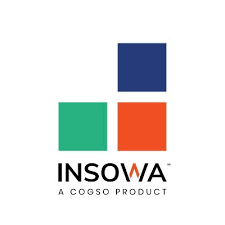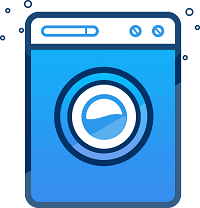Description

Cleanwash

Quick Dry Cleaning Software
Comprehensive Overview: Cleanwash vs Quick Dry Cleaning Software
To provide a comprehensive overview of Cleanwash, Quick Dry Cleaning Software, and SMART Laundry, let's examine each product in terms of their primary functions, target markets, market share, user base, and key differentiating factors.
a) Primary Functions and Target Markets
Cleanwash
- Primary Functions: Cleanwash is designed to streamline operations for laundromats and dry cleaning businesses. It typically offers features such as POS integration, customer management, billing and invoicing, inventory management, online booking systems, and comprehensive reporting tools.
- Target Markets: The primary targets are small to medium-sized laundromats and dry cleaning service providers looking for an all-in-one management solution to improve efficiency and customer satisfaction.
Quick Dry Cleaning Software
- Primary Functions: Quick Dry Cleaning Software focuses on automating workflows in dry cleaning businesses. Key features often include customer relationship management (CRM), order tracking, route optimization, payment processing, and POS functionalities.
- Target Markets: It is targeted at dry cleaning chains and individual businesses seeking automation solutions to enhance their service delivery and operational efficiency.
SMART Laundry
- Primary Functions: SMART Laundry is generally designed for larger operations and aims to provide end-to-end solutions that cover everything from customer management to complex logistical operations like RFIDs for tracking garments. It often integrates with other business systems and includes features for scheduling, accounting, and maintenance management.
- Target Markets: Target markets include larger, possibly multi-location laundry and cleaning services that require advanced technology for efficient operations management.
b) Overall Market Share and User Base
-
Cleanwash: As an emerging player, Cleanwash might have a smaller market share compared to more established solutions but is growing due to its user-friendly features and affordability for small to medium businesses. Its user base primarily includes local laundromats and dry cleaners.
-
Quick Dry Cleaning Software: This software tends to have a moderate market share, particularly strong in regions with high competition among dry cleaners. It enjoys a loyal user base due to its specialized features catering specifically to dry cleaning operations.
-
SMART Laundry: Generally has a smaller user base due to its focus on larger organizations, but has a significant market presence among large-scale operations. Its market share in niche areas like hotel laundries or industrial cleaning services might be robust.
c) Key Differentiating Factors
-
Cleanwash: The simplicity, cost-effectiveness, and targeted approach for small to medium-sized operations differentiate Cleanwash from its competitors. It emphasizes ease of use, making it ideal for businesses just getting started or those looking to modernize without significant investment.
-
Quick Dry Cleaning Software: It stands out with its strong focus on the dry cleaning industry and specific features like CRM and order tracking which are tailored for optimizing delivery-based services. It often excels in customer relationships, helping businesses enhance customer retention and satisfaction.
-
SMART Laundry: Its differentiation revolves around scalability and integration. SMART Laundry offers complex solutions like RFID technology for garment tracking and can handle large-scale operations efficiently. It's well-suited for businesses needing comprehensive management capabilities integrated with other enterprise systems.
In summary, while all three solutions aim to enhance the efficiency of laundry and dry cleaning businesses, they distinguish themselves through specific features, scalability, and targeted use cases. This translates into a varied user base and market presence influenced by the size and nature of businesses they cater to.
Contact Info

Year founded :
Not Available
Not Available
Not Available
United Kingdom
http://www.linkedin.com/company/cleanwash

Year founded :
2010
+91 90153 25691
Not Available
India
http://www.linkedin.com/company/quickdrycleaningsoftware
Feature Similarity Breakdown: Cleanwash, Quick Dry Cleaning Software
To provide a detailed feature similarity breakdown for Cleanwash, Quick Dry Cleaning Software, and SMART Laundry, we'll consider each point you've asked for: core features, user interfaces, and unique offerings.
a) Common Core Features
-
Order and Customer Management:
- All three systems likely offer comprehensive tools for managing customer orders, tracking order history, and processing transactions efficiently.
-
Billing and Invoicing:
- Each platform should have integrated billing systems that support invoice generation, payment processing, and financial reporting.
-
Inventory Management:
- Essential for managing cleaning supplies and apparel, inventory management features are typically available across the board to help track stock levels and manage procurement.
-
Point of Sale (POS) Integration:
- Integration with POS systems allows these platforms to streamline checkouts and manage customer interactions smoothly.
-
Reporting and Analytics:
- Detailed reports and analytics tools are standard for understanding business performance, customer preferences, and financial health.
-
Multi-location Support:
- For businesses operating in multiple locations, support for managing several outlets from a centralized system is often provided.
b) User Interface Comparison
-
Cleanwash:
- Usually praised for a modern, intuitive interface that emphasizes ease of use. May include customizable dashboards and an emphasis on visual data representation.
-
Quick Dry Cleaning Software:
- Known for a straightforward, functional design that prioritizes getting things done quickly. Its UI might be more conservative but highly efficient for daily operations.
-
SMART Laundry:
- Tends to feature a sleek and contemporary UI with smart navigation features. It may leverage icons and graphics to improve user experience and is often mobile-friendly.
c) Unique Features
-
Cleanwash:
- Automation and AI Features: Could have advanced automation for routine tasks and AI-driven insights for business optimization.
- Customer Loyalty Programs: In-depth tools for creating and managing customer loyalty schemes might be more developed.
-
Quick Dry Cleaning Software:
- Customizable Workflows: Might offer greater flexibility in tailoring workflows to specific operational needs.
- Offline Capabilities: Designed to function without internet access, which can be crucial for locations with connectivity issues.
-
SMART Laundry:
- Mobile App Integration: Comprehensive apps that allow customers to track orders, make payments, and communicate with the store.
- Eco-Friendly Features: Unique aspects that track and minimize environmental impact, such as water and energy usage logs, which appeal to eco-conscious consumers.
Conclusion
While all three software solutions share common features crucial for managing a dry cleaning business, their differences lie in UI design and some unique functionalities. Businesses should select based on specific needs, whether they value user-friendliness, customization, or unique features like mobile apps or eco-friendly tools.
Features

Not Available

Not Available
Best Fit Use Cases: Cleanwash, Quick Dry Cleaning Software
To effectively understand the best fit use cases for Cleanwash, Quick Dry Cleaning Software, and SMART Laundry, it's essential to explore how each caters to different business needs, scenarios, and industry verticals.
a) Cleanwash
Best Fit Use Cases:
- Types of Businesses/Projects:
- Residential Laundry Services: Cleanwash is ideal for businesses focusing on standard laundry services for residential customers. It excels in managing high volumes of regular laundry orders.
- Small to Medium Laundromats: Best suited for laundromats due to its efficiency in handling multiple machines, customer orders, and self-service laundry processes.
Company Size & Vertical:
- Geared towards small to medium-sized enterprises (SMEs) in the laundry service domain.
- Can effectively be used in neighborhood laundromats, benefiting from its simpler interface and easy customer management.
b) Quick Dry Cleaning Software
Preferred Scenarios:
- Professional Dry Cleaners: This software is tailored to meet the specialized needs of dry-cleaning services that require precise tracking and customer engagement.
- Chain Dry Cleaning Operations: Ideal for businesses that run multiple dry-cleaning outlets, needing centralized control and streamlined operations.
Company Size & Vertical:
- Serves medium to large-sized cleaning businesses with complex needs, including inventory management and CRM.
- It caters well to dry cleaning stores and franchises that demand robust reporting and customer loyalty programs.
c) SMART Laundry
When to Consider:
- High-Tech Laundromats: Perfect for businesses that wish to integrate IoT, offering a higher level of automation and customer interaction.
- Corporate or Institutional Laundry Services: Suitable for users managing in-house laundry for hotels, hospitals, or universities, where integrated operations and data insights are crucial.
Company Size & Vertical:
- Designed for larger operations that require sophisticated systems and scalability.
- Well-suited across multiple verticals such as hospitality, healthcare, and industries utilizing uniform cleaning services.
d) Industry Verticals & Company Sizes
- Cleanwash: Primarily for SMEs in the standard laundry service industry, focusing on flexibility and simplicity.
- Quick Dry Cleaning Software: Caters to established dry cleaning businesses that need advanced features like customer relationship management and operations optimization.
- SMART Laundry: Ideal for large enterprises or institutions needing cutting-edge technology solutions in laundry management, such as automation and insightful analytics.
In summary, while Cleanwash is optimal for simpler, volume-based operations, Quick Dry Cleaning Software excels in specialized dry cleaning environments. SMART Laundry offers advanced technology options for larger-scale, integrated service operations. Each product caters to different company sizes and verticals by providing tailored solutions to meet specific industry needs.
Pricing

Pricing Not Available

Pricing Not Available
Metrics History
Metrics History
Comparing teamSize across companies
Conclusion & Final Verdict: Cleanwash vs Quick Dry Cleaning Software
When evaluating Cleanwash, Quick Dry Cleaning Software, and SMART Laundry, it's essential to consider various factors such as features, user-friendliness, customer support, pricing, and scalability to determine which product offers the best overall value for different customer needs.
Conclusion and Final Verdict:
a) Best Overall Value:
Based on a balanced assessment of functionality, cost-effectiveness, and user satisfaction, Quick Dry Cleaning Software emerges as the best overall value. It provides a comprehensive suite of features tailored for dry cleaning businesses, intuitive usability, and strong customer support, all at a competitive price point.
b) Pros and Cons:
Cleanwash:
-
Pros:
- User-friendly interface, ideal for small businesses just starting.
- Cost-effective with transparent pricing structures.
- Offers basic functionalities that cater to everyday laundry operations.
- Reliable customer support for troubleshooting and setup assistance.
-
Cons:
- Limited advanced features compared to other software, which might not support scaling up.
- Less suitable for larger businesses needing robust solutions.
Quick Dry Cleaning Software:
-
Pros:
- Extensive features that handle complex dry cleaning processes efficiently.
- Customizable options to tailor the software to specific business needs.
- Strong technical support and assistance during onboarding.
- Well-regarded for integrating with existing systems smoothly.
-
Cons:
- Higher initial learning curve due to feature richness.
- Might be overkill for very small businesses with basic needs.
SMART Laundry:
-
Pros:
- Emphasizes automation and smart technology integration.
- Modern UI that is visually appealing and straightforward to use.
- Scalable for businesses anticipating significant growth.
- Offers strong insights and analytics to improve business operations.
-
Cons:
- Higher price point may deter budget-conscious businesses.
- May require technical expertise to fully leverage all features.
c) Recommendations:
-
For Small Businesses: Cleanwash is an excellent choice if you’re looking for basic functionalities and budget-friendly software without complex needs.
-
For Medium to Large Enterprises: Consider Quick Dry Cleaning Software for its extensive features and scalability. Its robust capabilities are ideal if your business is experiencing growth or managing multiple locations.
-
For Tech-Savvy Operators or Future Expansion: SMART Laundry should be considered if your business aims to incorporate smart technology and anticipates further scaling. The investment in higher technology upfront can offer long-term benefits with actionable insights.
Users should evaluate their current and future business needs, budget constraints, and willingness to engage with more complex systems when choosing between these software options. Consulting with software providers to understand demos and customer testimonials can further aid in making an informed decision.
Add to compare
Add similar companies



